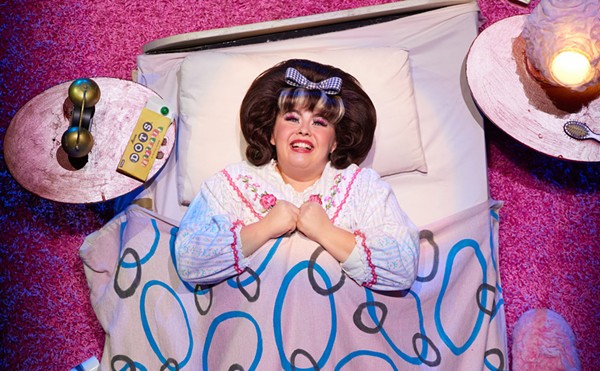The reality show Project Runway has proven a couple of interesting points since it began in 2004. First, the show’s popularity demonstrates that the fashion world has officially penetrated the American psyche. Second, coming up with innovative ideas is not easy. The fashion world claims to have “seen everything.” The music industry claims to have “heard everything.” Essentially, at the end of the aughts, we’re living in a post-everything reality.
“Mashup” feels like an appropriate word to describe the aughts — an era that appeared both nostalgic and futuristic as it shamelessly borrowed trends, shapes, and moods from past decades. The ’80s ruled as the official “idea closet” for fashion designers and DJs alike. In music, the genre “bastard pop” brought mashups to the mainstream, providing us with a seemingly endless supply of familiar songs fused together and then sprinkled with a little magic borrowed from yet another source. A recent fashion fixation (and example of trend recycling) is the shoulder pad. Take a concept most people swore they would never wear again, rethink it (in this case exaggerate it), and presto! The “architectural” shoulder is born. Or consider the MC Hammer pant, a shape that took inspiration from I Dream of Genie-worthy harem bloomers; now reinterpreted (in this case, they’re tighter and often cropped), we have “drop-crotch” pants. These designs are sold in chic boutiques alongside expensive new versions of ’70s-era pantsuits and skin-tight versions of ’50s-era pegged blue jeans (commonly referred to as “stove pipes” or “drain pipes”), a telling example of the decade-spanning mashup that gave the aughts a mild case of schizophrenia.
Globalization is a word we heard a lot in the aughts. As cities from São Paolo to Beijing and (pinch us, are we dreaming?) San Antonio claimed fashion weeks of their own, fashion designers everywhere spun the globe for inspiration. Trendsetters on both sides of the Atlantic took cues from African and Native American culture and textile design to create collections that brought to mind fearlessly dressed nomads (with trust funds) trotting the globe in surrealistic spike heels (Balenciaga’s $4,175 Lego-inspired pair have a rugged sole perfect for a fashionable trek in the desert). Green practices and sustainable fabric choices have also become pervasive concepts over the last decade and will undoubtedly continue to influence clothing production on a global level.
Throughout the aughts, a large percentage of ready-to-wear collections looked like familiar, grown-up versions of clothes many of us wore as children. What’s funny is that a lot of us were ready to wear these styles again. Marc Jacobs, possibly the designer for the aughts, not only made millions selling covetable (and extremely wearable) clothing based on vintage styles for his own eponymous lines, but revamped the house of Louis Vuitton by adding whimsy to the house’s leather-goods line via high-profile collaborations with trendy contemporary artists. Japanese artist Takashi Murakami’s LV collaboration produced a sold-out collection of bags and accessories that remixed the house’s iconic logo print in 33 candy colors with curious, unexpected elements like anime, cherries, and smiley faces.
Surprising to many (tasteless to some) was the presence of a functional pop-up Louis Vuitton store at Murakami’s retrospective at the Museum of Contemporary Art in Los Angeles and the Brooklyn Museum. This is perhaps the fashion factoid for the aughts. It’s evidence that the fashion and art worlds have finally tied the knot, but digging deeper, the idea of pop-up retail came of age in the aughts and has proven to be a success in the world’s fashion capitals. Seemingly overnight (and in some cases, literally overnight) temporary structures appeared for a limited time, to sell limited-edition items such as music producer Mark Ronson’s sneaker designs for Gucci, which cost upwards of $500 a pair.
Murakami’s work is also a perfect example of “high-low,” a trend that became popular during the aughts. Murakami blurs the lines between “high” and “low” art by incorporating painting, digital processes, and elements of popular culture to create functional objects like figurines, soccer balls — even wallpaper. In sartorial terms, the words “high” and “low” became close friends in a different sense thanks to the trend of pairing expensive accessories with wallet-friendly vintage clothes (or costume jewelry with couture, for example). With vintage garments being the inspiration for so many collections, smart fashion addicts went shopping in their climate-controlled storage units, and spent their money on the must-have shoes and bags of the moment. By taking risks (and possibly evolving more quickly than apparel lines), designer bags and shoes rendered themselves indispensable to the aughts and will be important symbols of the look of the decade.
The word “special” has taken on new meaning recently in the fashion trade, which brings to mind a certain boutique that’s causing quite a stir. Ikram is a forward-thinking Chicago boutique owned by Ikram Goldman. Rather than selling the expected, Ikram focuses on emerging designers that make “special” clothes. The boutique blipped onto everyone’s radar when Goldman emerged as Michelle Obama’s fashion advisor. Suddenly (thanks to Goldman’s buying practices) designers Jason Wu, Isabel Toledo and Thakoon have been catapulted onto fashion’s front page. Not since Jackie O. has a First Lady made such an impact with fashion choices (she also rocks the high-low look by wearing J. Crew with a touch of bling). It’s safe to say Michelle Obama is not in danger of “pulling a Laura Bush” by showing up at an event wearing the same red Oscar de la Renta gown as three other women. Change? Yes, we did. •
















